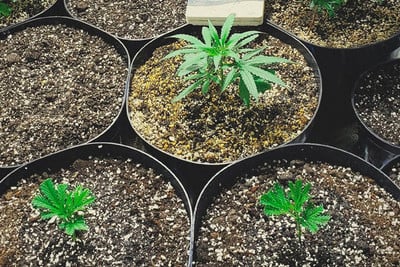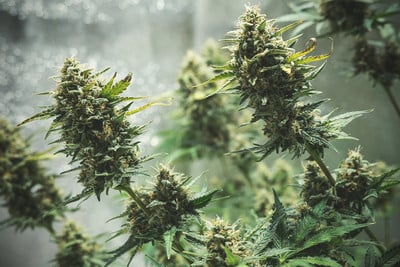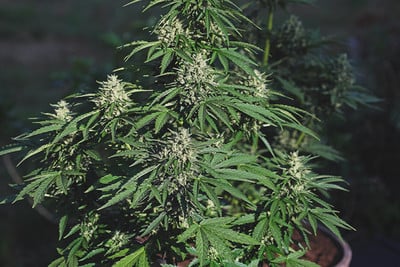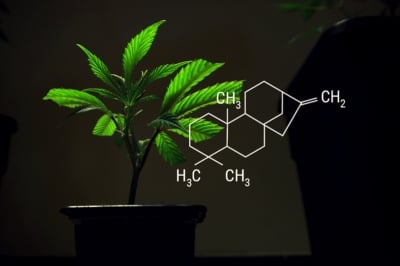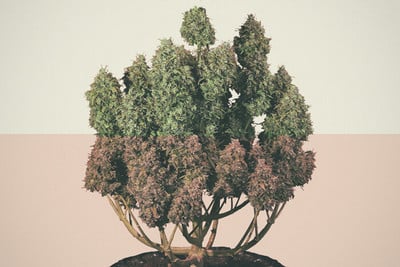.

Can You Clone Autoflower Cannabis Plants?
Autoflowering cannabis strains are incredibly popular among cannabis growers, owing to their long list of impressive advantages. They're compact and quick to grow, but offer serious potency and big yields. But how to autos perform when it comes to cloning? Do they produce healthy and functional plants? Or do autos really have an Achille's heel?
Autoflowering plants produce a sizeable haul over an extremely short period of time. Modern varieties also often outcompete many photoperiod strains when it comes to potency and yield. Many growers are autoflowering purists and view these varieties as flawless and incredibly efficient.
While they're truly marvels of breeding, they do possess one distinct downside. Find out why autos aren't compatible with cloning below, and discover an easy alternative.
Contents:
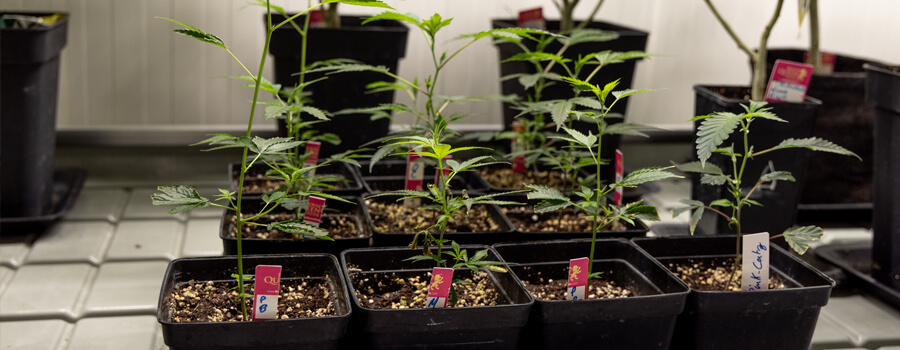
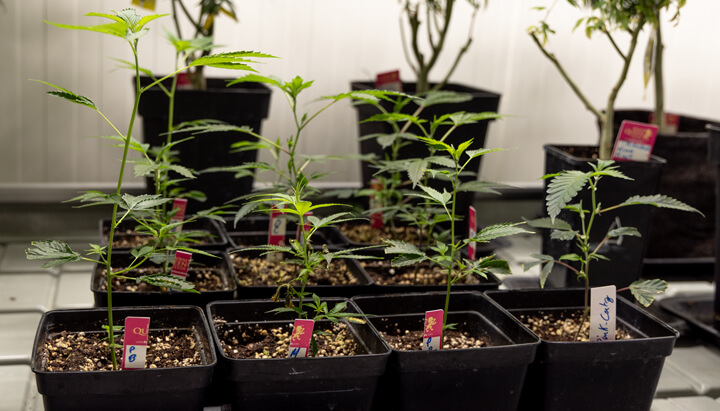
Understanding Autoflowering Cannabis Plants
Even if you’re new to cannabis cultivation, you’ll likely have come across the vast amount of strains available to growers. Since its domestication[1] in northwest China approximately 12,000 years ago, humans have used selective breeding to drastically alter this crop; many modern cultivars differ greatly in both morphology and chemistry from the wild-type plants our species first encountered.
Unlike photoperiod cultivars, and as their name implies, these plants don’t rely on external light cycles to force them to flower. Instead, they do it all on their own, which makes growing them a much briefer affair.
Overall, autoflowering cannabis varieties are smaller and grow much faster, while still offering excellent potency and productivity.
How Do Autoflowering Plants Work?
If you’re wondering if you can clone autoflowers, it’ll help to go right back to the beginning of things. Ages prior to the human domestication of cannabis, the plant species emerged[2] on the eastern Tibetan Plateau. From here, natural dispersion[3] enabled the herb to transcend its prototypical boundaries and travel as far as modern-day Russia, India, South Korea, and south-eastern Europe. Each of these regions possesses different climates and environmental conditions, resulting in adaptations that gave rise to different subspecies of cannabis.
Among the emergent subspecies, that which developed in modern-day Russia developed perhaps the most unique adaptation. Previously, cannabis plants relied on waning seasonal light cycles to induce flowering. However, a combination of genetic mutations, natural selection, and environmental pressure gave rise to plants that bloom based on an internal genetic clock—a mechanism that helped them to survive in such a challenging region.
Modern breeding programs have since crossed this pure ruderalis with other cannabis subspecies. This process has created strains that possess the autoflowering trait, along with higher levels of cannabinoids and terpenes, and superior productivity.
The Science of Cloning Cannabis
Can you clone an autoflower?
The science of cloning weed involves taking cuttings from a mother plant. This plant material possesses the exact same genome as the mother; in essence, you’re simply multiplying the original plant. The emergent specimen will possess all of the same traits and become established quicker than a plant grown from seed.
To understand the science of cloning, it helps to know what the process entails:
- Mother plant selection: First things first, growers need to select a mother plant to take a cutting from. The selection process hinges entirely on the desired traits of the mother. Considering the clone will possess the same characteristics, this is the most important step of the entire process.
- Cuttings are taken: Next, the grower will take a cutting using a sharp and sterile cutting tool to avoid transmitting disease. The cutting must contain at least one node; these structures contain meristematic cells that are capable of producing new roots and shoots.
- Rooting: The grower then dips the severed end of the cutting into a rooting hormone formula and places it into a rooting medium.
- Transplanting: After carefully maintaining a tight range of temperature and humidity, the cutting will produce a healthy root system. From here, the grower can transplant the clone into a soil-based growing medium.
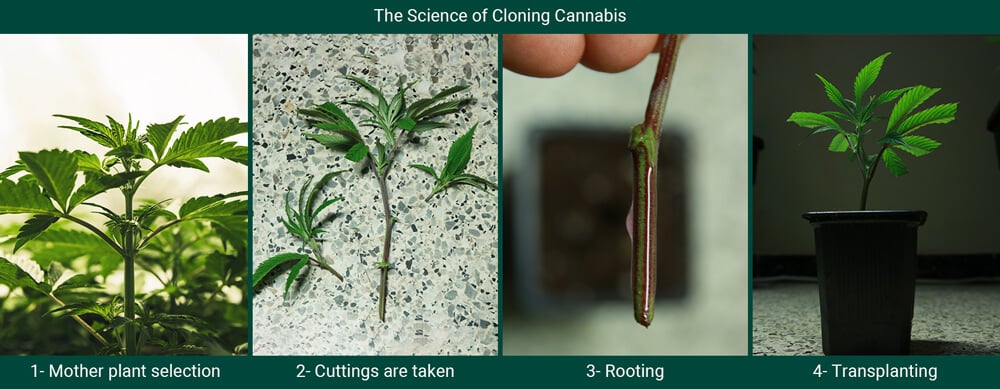
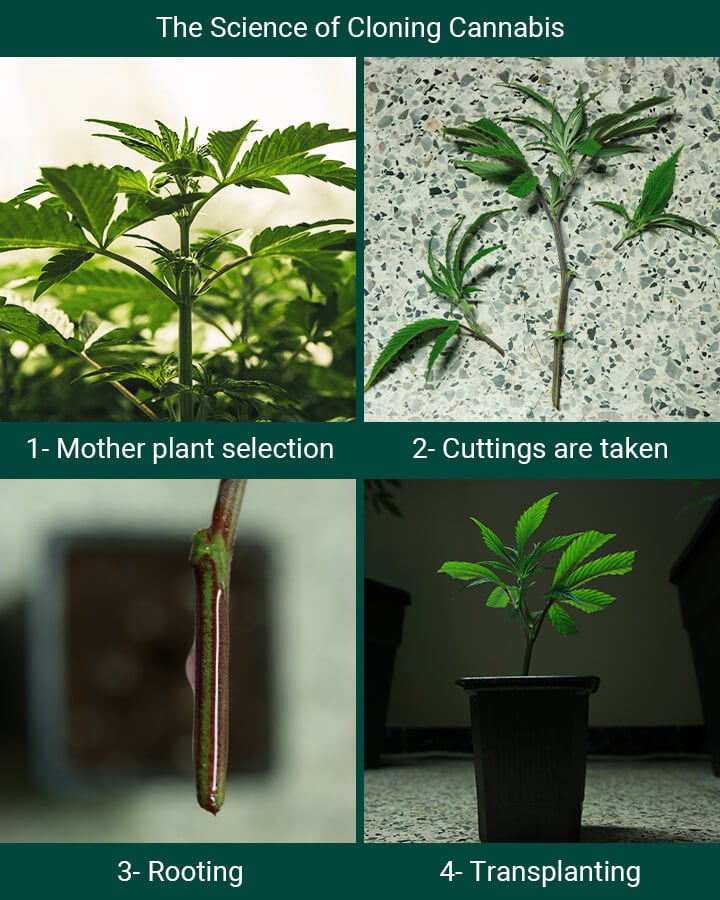
What Are The Benefits of Cloning Weed Plants?
This technique provides many key benefits, including:
- Genetic consistency: Cuttings are a direct genetic copy of their mother plant. Minus spatial separation, they are essentially the same plant. This means growers know exactly what they’re going to get during the next growing cycle.
- Phenotype capture: Cannabis plants from the same batch of seeds all possess some degree of genetic variability. Some phenotypes will produce a more desired shape, size, or phytochemical composition. Cloning allows growers to capture and maintain a select phenotype, without losing any of its desirable traits.
- Fertilisation prevention: Cloning female plants allows cultivators to produce a batch of only female clones. Minus the minute risk of hermaphroditism, this eliminates the risk of males entering the growing space and potentially fertilising the female flowers and, consequently, reducing their quality.
- Faster turnaround: Taking cuttings erases the need to start cannabis plants from seed. Not only does this save time, but it eliminates some of the problems that can arise during the seedling phase, including fungal root diseases. This faster turnaround proves profitable commercially and also gives home growers a headstart when it comes to procuring a fresh stash.
- Horticultural skill development: If you’ve only ever started a plant from seed, learning how to properly clone plants will add a notch to your horticultural belt.
Is It Possible to Clone Autoflowering Cannabis?
You’re now familiar with autoflowering genetics and the process of cloning cannabis in general. But can you clone autoflowering plants? Technically, yes. Autoflowering plants are no different to other types when it comes to the process of cloning. However, the results differ drastically.
Taking a cutting from an autoflowering plant will, if handled correctly, yield a healthy clone. These cuttings are capable of producing roots and vegetative growth under the correct conditions. Likewise, they’re also an exact genetic copy of the mother plant and will therefore exhibit the same characteristics.
This all sounds well and good, right? But just because you can clone an autoflowering weed plant, it doesn’t mean that you should.
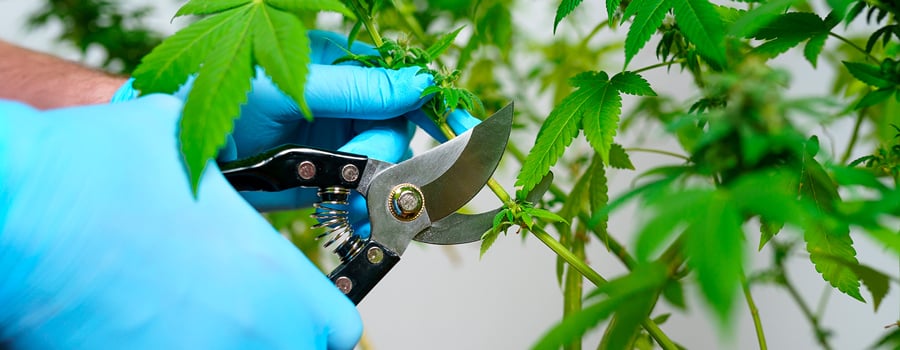
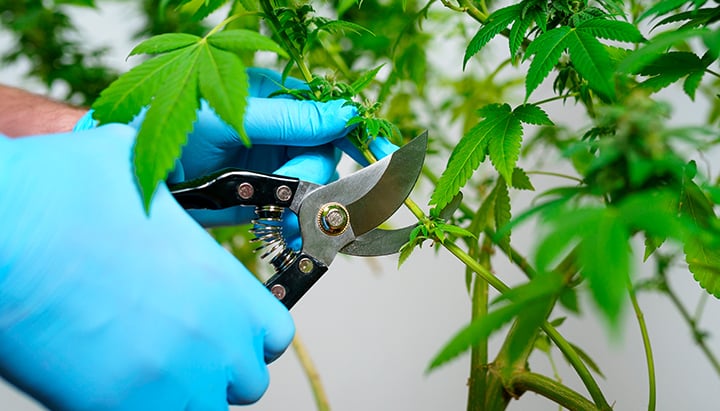
Why You Shouldn’t Clone Autoflowers
The autoflowering trait makes autos highly desirable among many growers. However, this same property makes them incompatible when it comes to cloning. The internal genetic clock of an auto, which dictates when flowering will take place, never stops ticking—this raises a major problem.
The average auto has a lifespan of around 10–12 weeks from germination to harvest. It’ll take around 3–4 weeks for a plant to grow large enough to take a viable cutting. Successful rooting and the establishment of the clone will take another 1–2 weeks. This leaves only eight weeks, at the very maximum, for the cutting to develop into a mature flowering plant. In the worst-case scenario, the specimen will have only six weeks before it reaches the end of the flowering stage. Realistically, before the grower even has the chance to take a cutting, the plant will have started to enter the early stages of bloom.
By the time the cutting becomes established, you’ll essentially have little more than a couple of preflowers on the end of a stick. With the vegetative phase virtually over before the grower took cuttings, the clone will exhibit little to no vegetative development and will fail to put on size and mature properly. To put it simply—you just wasted your time and unnecessarily removed a large chunk of living tissue from your original plant.
How Cloning Photoperiod Strains Differs From Autos
In contrast, photoperiod plants are perfectly compatible with cloning. Remember, they don’t flower based on an internal genetic clock. Instead, they rely on external light cues in the form of a reduction in the light cycle. In a controlled growing environment, growers have complete control over the amount of light their plants receive.
When exposed to at least 13 hours of light per day, photoperiod plants will stay in the vegetative phase indefinitely. This means cultivators can keep their clones exposed to enough light to allow them to become fully-grown vegetative plants before switching them into bloom.
Cloning Autoflowering Strains: Don’t Waste Your Time
Cloning autoflowering plants seems like a good idea at first, especially to growers that have recently discovered a perfect phenotype that matches all of their preferences. Unfortunately, taking cuttings from autos results in little more than wasted time. If you grow conventional autoflowering plants, you’ll simply have to accept the fact that you’ll need to start from seeds at the start of each growing cycle and bear the genetic variability within your crop.
While cloning remains fruitless when growing autos, breeding has come a long way in recent years. Now, auto growers have a real alternative to this horticultural practice.
F1 Hybrids: A Superior Alternative to Cloning Autos
The agricultural sector has benefited from F1 hybrid crops for decades. However, they’re only a recent development within the world of weed. Our breeders here at Royal Queen Seeds successfully created the first true cannabis F1 hybrids. The highly technical and arduous processes start by creating several highly pure lines of genetics. By crossing these lines, our breeders created progenies that possess a trait known as hybrid vigour.
Not only does hybrid vigour endow plants with higher yields, faster growth, and increased pest and disease resistance, but it also means they possess unparalleled uniformity. Conventional autoflowering plants of the same batch of seeds display a large amount of genetic variation; some are taller, others shorter; some are more potent, while others lack THC and terpenes. F1 hybrids sidestep this problem by producing plants that all look, taste, feel, and produce the same.
In essence, autoflowering F1 hybrids are as close to cloning as you can get when growing this type of weed. Every time you sow a seed, you’ll know exactly what to expect. Keep your environmental variables tightly tuned, and you’ll get the same results every time you grow out an F1 autoflowering seed!
- Cannabis was domesticated in north-west China around 12,000 years ago | New Scientist https://www.newscientist.com
- Oldest evidence of marijuana use discovered in 2500-year-old cemetery in peaks of western China https://www.science.org
- Origin, early expansion, domestication and anthropogenic diffusion of Cannabis https://www.sciencedirect.com


























